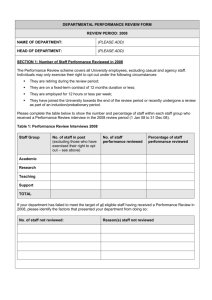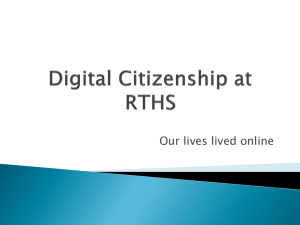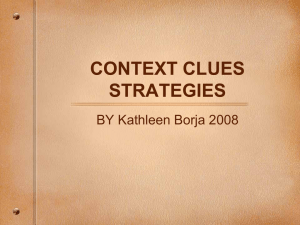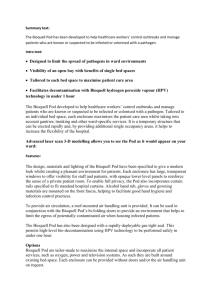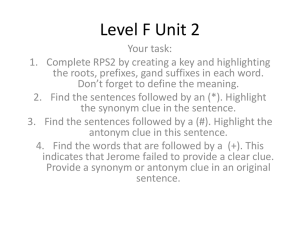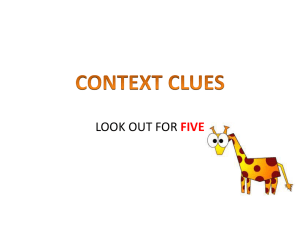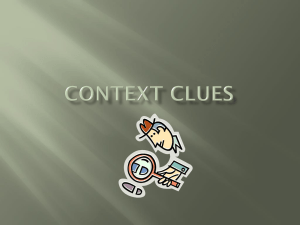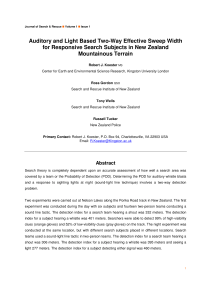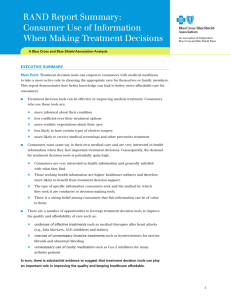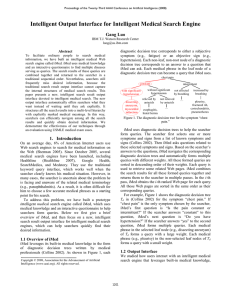Halifax Regional Search and Rescue Team Leader Module
advertisement
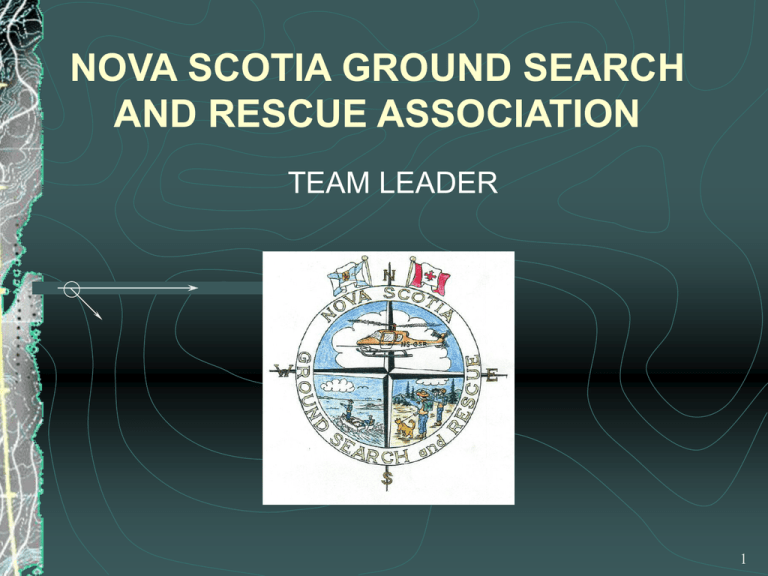
NOVA SCOTIA GROUND SEARCH AND RESCUE ASSOCIATION TEAM LEADER 1 Search Teams Most valuable component of Search Success - desire, ability and knowledge Team Leadership key 2 Team Leader considerations Responsibilities and Expectations Search Management Deal with situations Team’s contribution Ability to motivate and control team 3 Role of the Team Leader To ensure the safety of searchers under their authority To manage the tactical operation of the Team To inspire the team To deal effectively with emerging problems To report accurately on the Teams accomplishments 4 Searchers and Leaders What is the job of the Searcher? To search for clues - not necessarily to find any Probability of Detection (POD) is the measurement of Search Thoroughness What is the job of the Team Leader? To manage the process of searching and to judge the quality of the search effort Obtain highest POD possible Accurately report POD 5 Qualities of Leadership 80% Desire 10% Ability 10% Knowledge 6 Principals of Leadership Know your job Seek self Improvement Know your team Keep them informed Set the example Ensure task is understood Make sound and timely decisions Keep expectations within reason When you run out of ideas use your team! 7 Leadership styles Directive Supportive Participative Achievement Oriented 8 Be Decisive Base decisions on task success A wrong decision is often better than no decision If unsure, seek an opinion, but YOU decide Don’t abdicate: a committee is less effective than a team 9 Traits of Leadership Alertness Decisiveness Enthusiasm Humility Judgement Sympathy Bearing Dependability Force Initiative Justice Tact Courage Endurance Humor Integrity Loyalty Unselfishness 10 Results of Leadership Discipline Morale Efficiency 11 Team Leader Knowledge Search Urgency Teams Goal Team Members skills HRSAR Equipment HRSAR Process & Procedures 12 Passive Search Techniques Stringlines Observation Posts Confinement sites 13 Note Taking Why How Importance 14 Incident Command System Incident Comander (Police) SAR Manager Safety Officer Plans Operations Communications Logistics Team Leader Searchers 15 Search activities Call from Police to Search Director (SD) SD contact drivers, overhead, alarm operator Overhead develop strategy on-site Searchers make site ready Plans brief Team Leaders of tasks Teams complete taskings Teams debriefed by Plans Search Complete, site takedown 16 Team Leader Briefing Big Picture ( Search Mgmt ) Team Goal ( POD ) Get the facts Lost person description Team Methods ( tactics ) Search area, maps Data recording capability Special Instructions 17 Tasking Form HALIFAX REGIONAL SEARCH AND RESCUE TEAM 1. Incident Name TASK ASSIGNMENT FORM 5. Operational Period 2. Date Prepared 4. Task/Team No. 3. Time Prepared 6. Date of Assignment 8. Time End Assignment 7. Time Began Assignment 9. Instructions 11. Transportation and Routing Information 12. Function 13. Name 14. Special Skill 15. At Briefing 16. Team 1. Team Leader 2. 3. 4. 5. 6. 18 Team Briefing Know your team Motivate - All team members must have the same “mind’s eye view” Describe the assignment Subject Profile Teams capabilities and restrictions Equipment checklist 19 The clue list: Confidential Subject physical profile Name Description Clothes Medical Carrying? > safety concerns? 20 Four Stages of a Tasking Locate the subject Reach the subject Stabilize the subject Rescue/recovery 21 Taskings Plan positions in advance for Type 1, 2 & 3 Know team members strengths Compass person, radio person, flagging person Explain assignments, be clear and specific Delegate by name Ask, and expect, to be informed Monitor progress Document events and clues 22 Hasty Team - Type 1 TL 1-3 m 1-3m 23 Open Grid - Type 2 15m TL 15m Closed Grid - Type 3 7m TL 24 Manage Don’t Search Keep hands off Take in the big picture Let the team do the work You steer the team Delegate and/or appoint Assistant Team Leaders 25 Communications Radio’s dispatched by Communications Officer Communications Do’s & Don’ts Communication Etiquette Intersquad Communications 26 Being Lost Has it happened to you? Prevention - map & compass knowledge, safety bearing Compass person leads on bearing All searchers have safety bearing 27 Team Safety Top priority Always on Safety Practices Safety Equipment Rest Breaks Nourishment 28 Finding A Clue Clue evaluation - age, relevance to lost subject Clue protection - weather, people Documentation - location, date and time, weather Command Notification 29 Control the Team Keep them on the task Keep them all heading in the same direction Control unprofessionalism: horseplay, humor, anti-subject talk, behavior, etc Appear professional and efficient Watch and maintain morale 30 Common Problems of team unrest Moving too fast Loss of desire Team Leaders uncertainty or failure to assert authority. Team Leader not properly equipped 31 Maintain Morale Allow some latitude in trying circumstances Watch for fatigue, stress, etc Your job is to look after your team! 32 Emergency Situations Finding the lost person Finding a deceased person Searcher injury Unwilling lost subject 33 Debriefing Process: Phase 1 - Team Leader and Team complete Tasking Form Explicit description of area searched POD of search Location and description of clues Gaps in coverage Description of hazards Communication problems Suggestions and recommendations 34 Debriefing Process: Phase 2 - Team Leader and Plans Chief all items covered off in Phase 1 with team members any praises or issues with Team members 35 Debriefing - 3 Steps to Success What went right? be constructive praise where praise is due What went wrong? accept criticism but don’t take personally if you must get critical, don’t get personal What can be done better? look for improvements plan for next time 36 Critical Incident Stress Debriefing Critical Incident Stress caused by various situations affects everyone to different degrees know how to recognize it ask for assistance in handling it Separate course to address subject in detail, all Searchers should attend. 37 Other Situations Spontaneous volunteers skill level reason for joining special knowledge of area Relatives state of mind feelings magnified 38 Other Situations Media Direct questions to IC. When Ok to talk to? Speak positive and professionally 39 Other Situations Multi-team protocol Who is in control? Can control shift between teams? Are mixed teams possible? Yes 40 KNOTS Time to get you moving around, let’s make some knots. What are some of the basic knots used in SAR? When are they used? 41 P.O.D. The percentage of clues a resource would be expected to find given: The quality of the resource (dogs, helicopters, etc) The type of search tactic Factors affecting visibility – generally lower at night and terrain vs. weather 42 P.O.D. is: A measure of thoroughness of a single resource A measure of coverage after multiple searches (Cumulative POD) A measure objective for finding the lost person (mission POD) An indication of when it is time to expand the area being searched or suspend the search A measure of the value or quality of a search resource A yardstick by which all incident events are measured 43 Critical Separation 1 Critical Separation (CS) Searchers can barely detect target object (clue). 1 CS = 50% POD (or better) 44 Open Grid Type 2 50 ft POD TL 50 ft = 100 - (1/2 spacing) = 100 - (1/2 x 50) = 75% 45 Closed Grid Type 3 20 ft TL POD = 100 - (1/2 spacing) = 100 - (1/2 x 20) = 90% 46 Detrimental Effects on POD Weather Searcher Fatigue Searcher Expectations Searcher Morale Searcher Training Ineffective Team Leadership How many of these are directly linked to the Team Leader’s capabilities? 47 Time Too fast > POD is lower – hasty searching Too slow > searcher hours are wasted > Incident Objectives are not met >Subject becomes unresponsive • > Higher POD required……..!!!!! Must draw balance – Search Management Planning is a lot of work! 48 MAP Time not NAP Time A short Map exercise to get the brain energized. UTM Co-ordinates Magnetic declination Course plotting on maps Triangulation 49 Search Tactics Review Signcutting Binary Search Type I, II, III searching Efficiency vs. Effectiveness Critical Spacing 50 Why are so many visual clues missed? Even by trained clue conscious searchers 51 Minimize detection difficulties……. The clue is outside of central vision, so…………… Increase “ Dwell Time” ! Defined as the length of time a searcher looks at a particular spot Affects the searchers expectancy of clue detection Terminated by a decision that a clue is not there to be detected. Basically “ What you expect to see “ 52 Remember…………. Not one of us is as good as all of us! You get more bees with honey than you do vinegar! Who you are working for……………. 53
